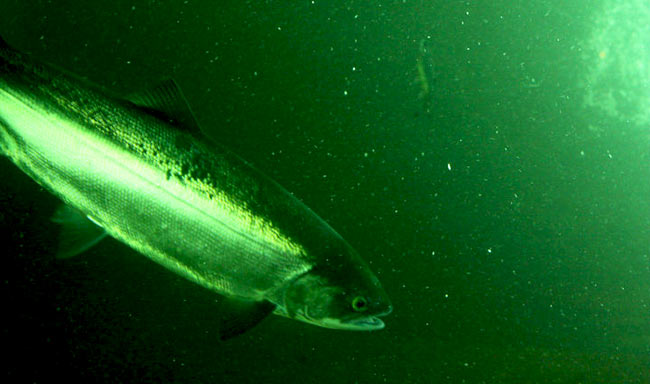News
“What we wanted to investigate was how the speed of an organism changes as a function of how large it is, how quickly it moves, and how much it moves,” said L. Mahadevan, the Lola England de Valpine Professor of Applied Mathematics, of Organismic and Evolutionary Biology, and of Physics. (File photo by Stephanie Mitchell, Harvard Staff Photographer.)

Like creatures that walk, swimming animals have a kind of "gait." Researchers at Harvard have analyzed the math and physics of swimming, finding surprising commonalities between species. (Photo by Caroline Perry, Harvard SEAS.)
At nearly 100 feet long and weighing as much as 170 tons, the blue whale is the largest creature on the planet, and by far the heaviest living thing ever seen on Earth. So there’s no way it could have anything in common with the tiniest fish larvae, which are mere millimeters in length and tip the scales at a fraction of a gram, right?
Not so fast, says L. Mahadevan, the Lola England de Valpine Professor of Applied Mathematics, of Organismic and Evolutionary Biology, and of Physics.
Using simple hydrodynamics, a team of researchers led by Mahadevan was able to show that a handful of principles govern how virtually every animal — from the tiniest fish, to birds, to gigantic whales — propel themselves though water. The study is described in a paper in Nature Physics this month.
“What we wanted to investigate was how the speed of an organism changes as a function of how large it is, how quickly it moves, and how much it moves,” Mahadevan said. “To resolve that in detail, however, is very complex, because there are a great deal of differences in morphology and what parts of the body different creatures use to swim. The question is: Is there anything in common across all these organisms? The answer, we found, is yes.”
In an effort to uncover those common principles, Mahadevan, working with a postdoctoral fellow in his group, Mattia Gazzola, and a colleague from the University of Nice, Médéric Argentina, began by trying to unpack the physics of how different creatures swim.
“The traditional approach to swimming phenomena is to take a certain specimen and accurately characterize it via experiments and/or simulations, and try to generalize from there. But it is very hard to strip out specific biological effects from general principles,” Gazzola said. “We instead thought that while swimmers exhibit a huge diversity in shapes and kinematics, at the end of the day they all live in the water.
“Therefore, we thought that if a unifying mechanistic principle existed, it had to lie in the constraints that the flow environment poses to all its inhabitants,” he continued. “And this is a purely physical problem, much easier to solve, since it is not affected by biological vagaries. What I like about this paper is that in one line of algebra we derived a compact formula that accounts for 50 years of experiments. This is an example of how powerful minimal modeling can be."
Read the entire article in the Harvard Gazette
Cutting-edge science delivered direct to your inbox.
Join the Harvard SEAS mailing list.
